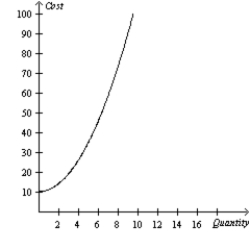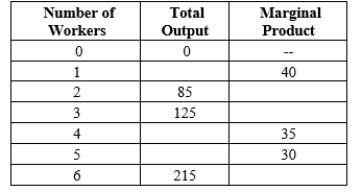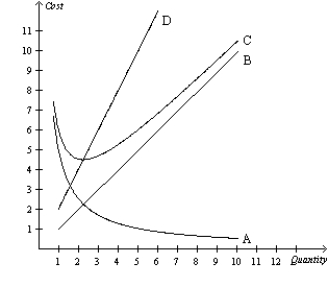A) maximize its total revenue.
B) maximize its profit.
C) minimize its explicit costs.
D) minimize its total cost.
F) A) and C)
Correct Answer

verified
Correct Answer
verified
Multiple Choice
Scenario 13-11 Walter builds birdhouses. He spends $5 on the materials for each birdhouse. He can build one in 30 minutes. He is semi-retired but earns $8 per hour at the local hardware store. He can sell a birdhouse for $20 each. -Refer to Scenario 13-11. An accountant would calculate the total cost for one birdhouse to be
A) $5.
B) $8.
C) $9.
D) $13.
F) A) and C)
Correct Answer

verified
Correct Answer
verified
Multiple Choice
When calculating a firm's profit, an economist will subtract only
A) explicit costs from total revenue because these are the only costs that can be measured explicitly.
B) implicit costs from total revenue because these include both the costs that can be directly measured as well as the costs that can be indirectly measured.
C) the opportunity costs from total revenue because these include both the implicit and explicit costs of the firm.
D) the marginal cost because the cost of the next unit is the only relevant cost.
F) A) and C)
Correct Answer

verified
Correct Answer
verified
Multiple Choice
Scenario 13-19 Doreen's Dairy produces and sells Swiss cheese. Last year, it produced 7,000 pounds and sold each pound for $6. In producing the 7,000 pounds, the dairy incurred variable costs of $28,000 and a total cost of $40,000. -Refer to Scenario 13-19. In producing the 7,000 pounds of cheese, the firm's average fixed cost was
A) $0.29.
B) $1.71.
C) $2,00.
D) $6.00.
F) B) and C)
Correct Answer

verified
Correct Answer
verified
Multiple Choice
Scenario 13-10 Jessica makes photo frames. She spends $5 on the materials for each photo frame. She can create one photo frame in an hour. She earns $10 per hour at a part-time job at the local coffee shop. She can sell a photo frame for $30 each. -Refer to Scenario 13-10. An accountant would calculate the total cost for one photo frame to be
A) $5.
B) $10.
C) $15.
D) $25.
F) B) and C)
Correct Answer

verified
Correct Answer
verified
Multiple Choice
Figure 13-3  -Refer to Figure 13-3. The graph illustrates a typical
-Refer to Figure 13-3. The graph illustrates a typical
A) total-cost curve.
B) production function.
C) production possibilities frontier.
D) fixed-cost curve.
F) C) and D)
Correct Answer

verified
Correct Answer
verified
Multiple Choice
If long-run average total cost decreases as the quantity of output increases, the firm is experiencing
A) economies of scale.
B) diseconomies of scale.
C) coordination problems arising from the large size of the firm.
D) fixed costs greatly exceeding variable costs.
F) None of the above
Correct Answer

verified
Correct Answer
verified
Multiple Choice
The marginal cost curve crosses the average total cost curve at
A) the efficient scale.
B) the minimum point on the average total cost curve.
C) a point where the marginal cost curve is rising.
D) All of the above are correct.
F) A) and C)
Correct Answer

verified
D
Correct Answer
verified
Multiple Choice
Table 13-7  -Refer to Table 13-7. At which number of workers does diminishing marginal product begin?
-Refer to Table 13-7. At which number of workers does diminishing marginal product begin?
A) 1
B) 2
C) 3
D) 4
F) B) and D)
Correct Answer

verified
Correct Answer
verified
True/False
Average variable cost is equal to total variable cost divided by quantity of output.
B) False
Correct Answer

verified
Correct Answer
verified
Multiple Choice
When a firm is operating at an efficient scale,
A) average variable cost is minimized.
B) average fixed cost is minimized.
C) average total cost is minimized.
D) marginal cost is minimized.
F) C) and D)
Correct Answer

verified
Correct Answer
verified
Multiple Choice
Analyzing the behavior of the firm enhances our understanding of
A) what decisions lie behind the market supply curve.
B) how consumers allocate their income to purchase scarce resources.
C) how financial institutions set interest rates.
D) whether resources are allocated fairly.
F) A) and B)
Correct Answer

verified
Correct Answer
verified
True/False
The cost of producing an additional unit of a good is not the same as the average cost of the good.
B) False
Correct Answer

verified
True
Correct Answer
verified
Multiple Choice
Scenario 13-1 Korie wants to start her own business making custom furniture. She can purchase a factory that costs $400,000. Korie currently has $500,000 in the bank earning 3 percent interest per year. -Refer to Scenario 13-1. Suppose Korie purchases the factory using $200,000 of her own money and $200,000 borrowed from a bank at an interest rate of 6 percent. What is Korie's annual opportunity cost of purchasing the factory?
A) $3,000
B) $6,000
C) $15,000
D) $18,000
F) C) and D)
Correct Answer

verified
Correct Answer
verified
Multiple Choice
Which of the following expressions is correct?
A) accounting profit = total revenue - explicit costs
B) economic profit = total revenue - implicit costs
C) economic profit = total revenue - explicit costs
D) Both a and b are correct.
F) A) and B)
Correct Answer

verified
Correct Answer
verified
Multiple Choice
Gwen has decided to start her own photography studio. To purchase the necessary equipment, Gwen withdrew $2,000 from her savings account, which was earning 3% interest, and borrowed an additional $4,000 from the bank at an interest rate of 7%. What is Gwen's annual opportunity cost of the financial capital that has been invested in the business?
A) $60
B) $280
C) $340
D) $660
F) C) and D)
Correct Answer

verified
Correct Answer
verified
Multiple Choice
Sebastian decides to open a tree farm. When deciding to open his own business, he turned down two separate job offers of $25,000 and $30,000 and withdrew $20,000 from his savings. Sebastian's savings account paid 3 percent interest. He also borrowed $20,000 from his brother, whom he pays 2 percent interest per year. He spent $15,000 to purchase supplies and earned $50,000 in revenue during his first year. Which of the following statements is correct?
A) Sebastian's total explicit costs are $15,400.
B) Sebastian's total implicit costs are $55,600.
C) Sebastian's accounting profit is $35,000.
D) Sebastian's economic profit is $4,600.
F) A) and D)
Correct Answer

verified
A
Correct Answer
verified
Multiple Choice
In his book, An Inquiry into the Nature and Causes of the Wealth of Nations, Adam Smith credits economies of scale to
A) competition.
B) opportunity costs.
C) specialization.
D) incentives.
F) A) and C)
Correct Answer

verified
Correct Answer
verified
Multiple Choice
Marginal cost is equal to
A) TC/Q.
B) ΔATC/Q.
C) ΔTC/ΔQ.
D) ΔQ/ΔTC.
F) C) and D)
Correct Answer

verified
Correct Answer
verified
Multiple Choice
Figure 13-5  -Refer to Figure 13-5. Curve D intersects curve C
-Refer to Figure 13-5. Curve D intersects curve C
A) where the firm maximizes profit.
B) at the minimum of average fixed cost.
C) at the efficient scale.
D) where fixed costs equal variable costs.
F) A) and B)
Correct Answer

verified
Correct Answer
verified
Showing 1 - 20 of 649
Related Exams